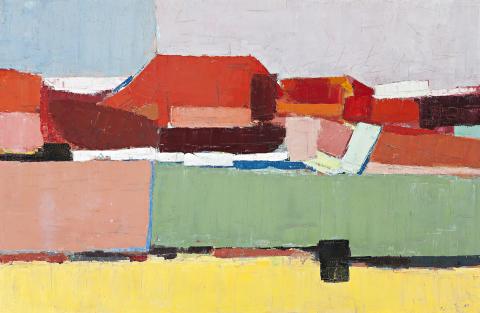MT VERNON, 1962
GUY GREY-SMITH
oil and beeswax emulsion on gauze on composition board
120.0 x 180.0 cm
signed and dated lower right: G. Grey Smith / 62
Skinner Galleries, Perth
Private collection, Perth, acquired from the above in 1962
Alcoa of Australia Limited, Western Australia
Sotheby’s, Melbourne, 21 August 1995, lot 18 (as ‘Landscape’)
Private collection, Perth
Arthur Spartalis Fine Art, Perth (as ‘Pilbara landscape’)
Private collection, Perth, acquired from the above in 1998
Guy Grey-Smith, Skinner Galleries, Perth, 30 April – 12 May 1962, cat. 1
Possibly: The Australian Painters 1964-1966, The Corcoran Gallery of Art, Washington, United States of America, 1967 (framers label verso: Philadelphia, United States of America)
20th Century Australian Painting, Fort Wayne Museum of Art, Fort Wayne, Indiana, 14 September – 28 October 1984 (as ‘Landscape’)
The Tony Hayes Selection, Claremont School of Art, Perth, 1996
Hutchings, P., ‘Smooth engine: Guy and Helen Grey-Smith, Skinner Gallery, Perth’, Sydney Bulletin, Sydney, 19 May 1963, pp. 56 – 57
Hutchings, P., ‘The Grey-Smiths’, The Critic, Perth, 25 May 1962, p. 82
Born and bred a country boy, Guy Grey-Smith took great delight in travelling through the rugged domains of his home state, Western Australia, experiencing spiritual sustenance and renewal with each new encounter. Given he had endured four harsh years confined as a prisoner of war in World War Two, it is hardly surprising that he should feel this way. With family members in tow, he would use the August school holiday break to travel north and, according to his son Mark, the one place he loved above all others was Mt Vernon on the Ashburton River. ‘Guy really loved that country. Mt Vernon is a tabletop mountain with a wonderful hard flat top, quite a feature. It’s set amidst open plains and distant hills, yet feels quite intimate, more condensed. There’s a beautiful colour in its rocks and spinifex – ochres, purples, yellows’.1 In this painting, Grey-Smith gives us his keen understanding of the majesty of the land and an emphatic rendering of its underlying ‘life force’.
Mt Vernon, 1962 comes from one of the most productive periods in the artist’s career, where a decade of study and experimentation had fused into his own personal vision. Through a distilled melting pot of European School influences including Cézanne, Rouault, and Nicolas de Staël, Grey-Smith had achieved a breakthrough the previous year with his monumental painting Horseshoe Range 1958-61.2 On seeing Mt Vernon at Skinner Galleries in 1962, the noted historian and critic Patrick Hutchings wrote ‘(i)t is interesting to contrast … Mt Vernon – with the big Horseshoe Range. The present canvas is less complex in texture and surface … but there is no loss of force. The rapid vibrations of the earlier paintings have given place to a more complex set of movements defined by simpler masses, and the picture is smoother, but no less satisfying than its predecessor.’3 Mt Vernon is constructed with reductive slabs of paint mixed fulsomely into a homemade beeswax medium. Foregoing brushes, Grey-Smith utilised paint scrapers of varying widths, a process which echoed his allied textural explorations in frescoes and ceramics.
With its sweeping passages of sage green, yellow and pink across its lower half, Grey-Smith suggests the fertility of the land, its wildflowers and scrub spreading beneath shadowed peaks articulated in oxide and umber. On considering Mt Vernon again after a distance of fifty years, Patrick Hutchings reminds us that ‘(t)he flat, the boring, the empty, never deterred Guy Grey-Smith. He made something of it. A specialist in landforms would see one thing: Guy Grey-Smith makes us see another. Not a fact about the landscape, but a visual analogue of one.’4
1. Grey-Smith, M., conversation with the author, 16 February 2016
2. In the collection of Art Gallery of Western Australia, Perth
3. Hutchings, P., ‘The Grey-Smiths’, The Critic, Perth, 25 May 1962, p. 82
4. Hutchings, P., correspondence with the author, 13 February 2016
ANDREW GAYNOR
Author of Guy Grey-Smith: Life Force, UWA Publishing, Perth, 2012
